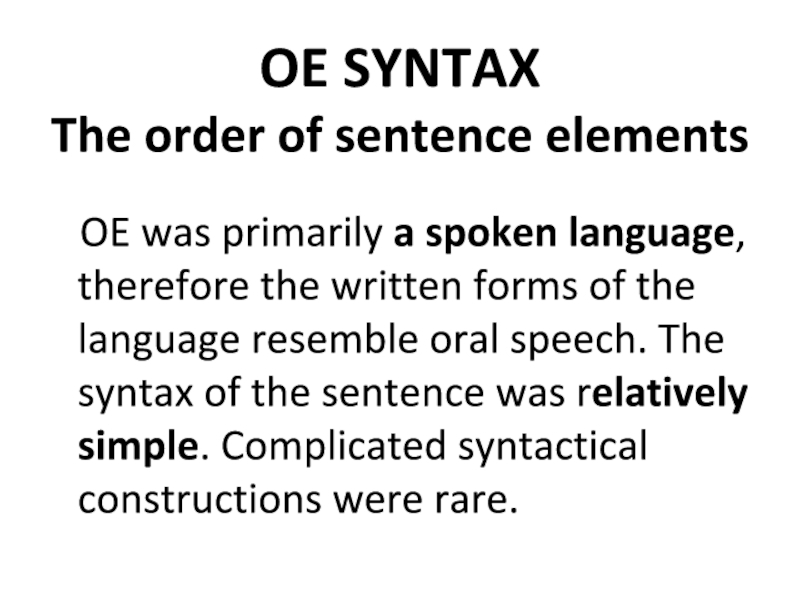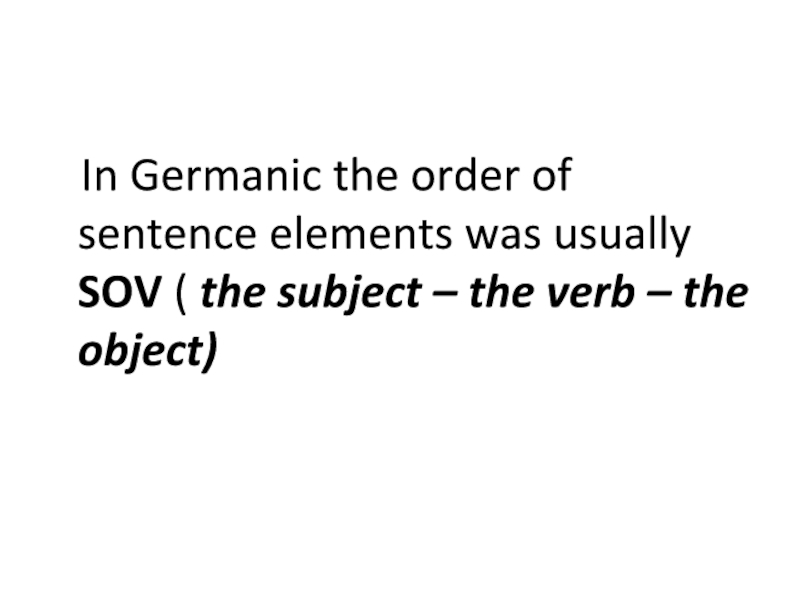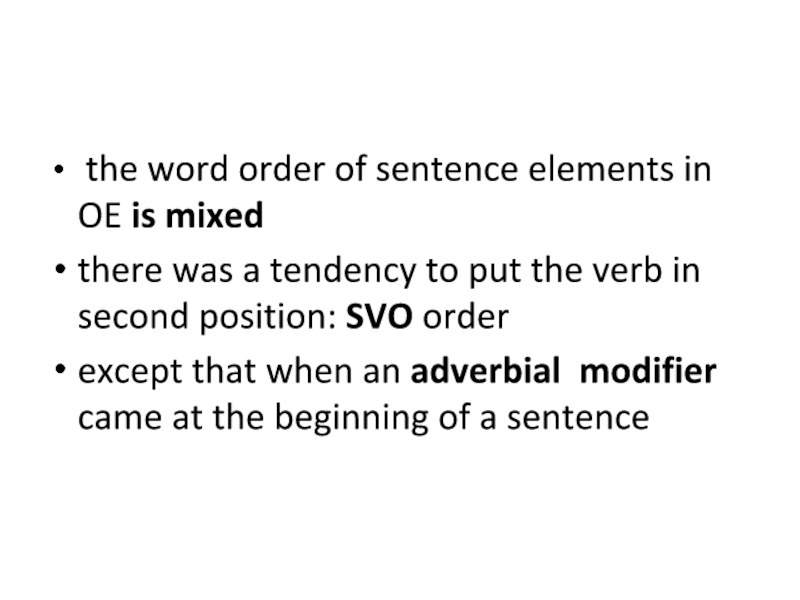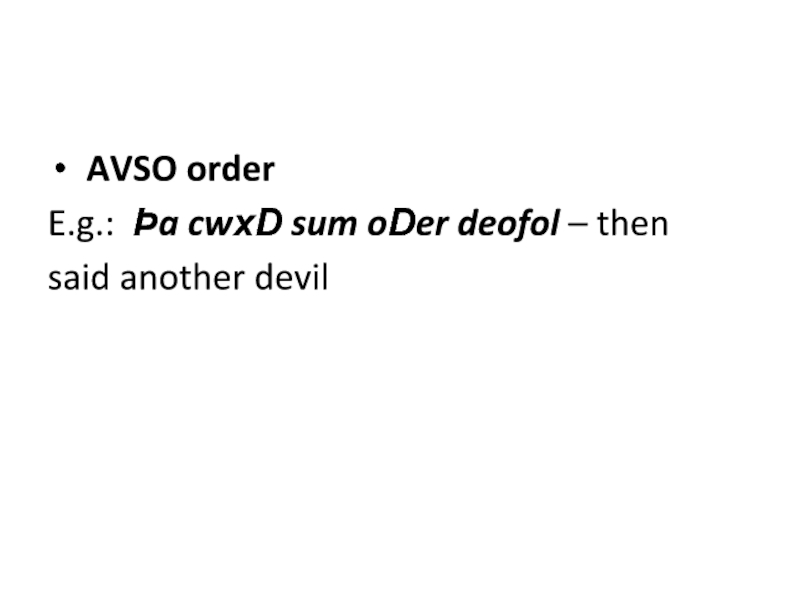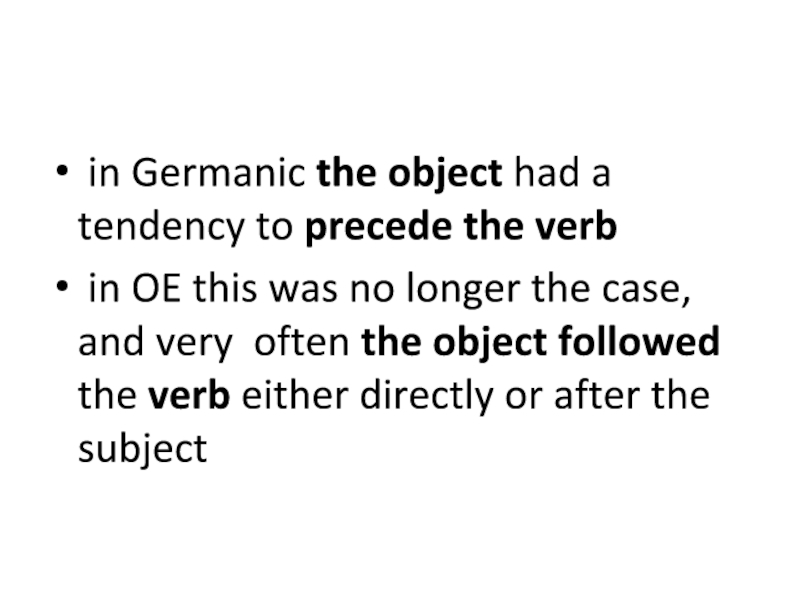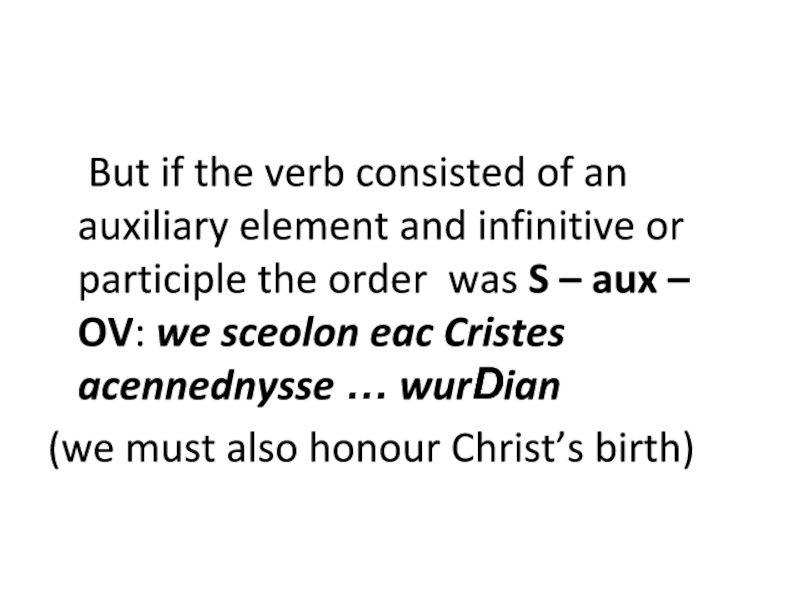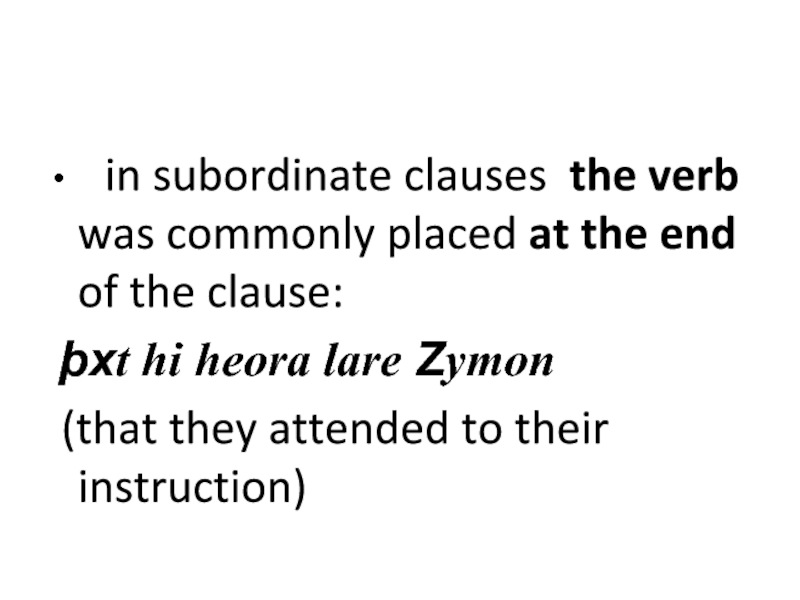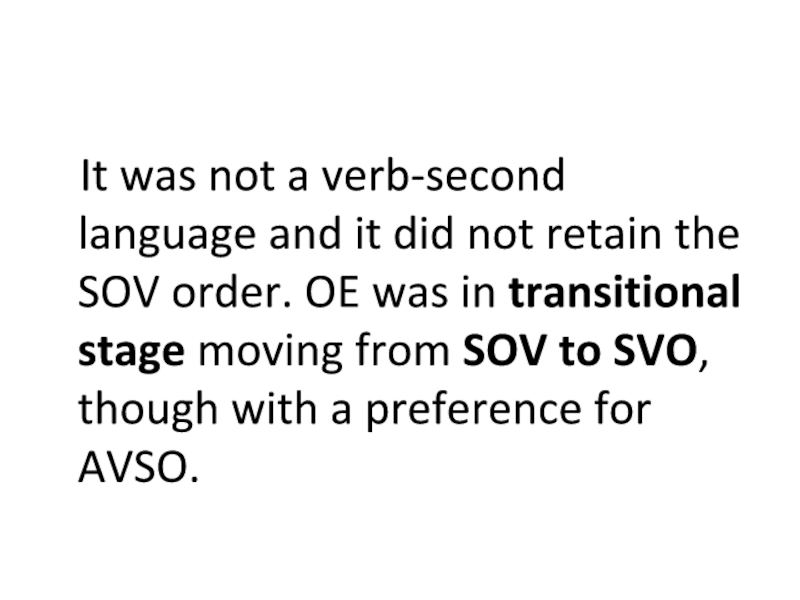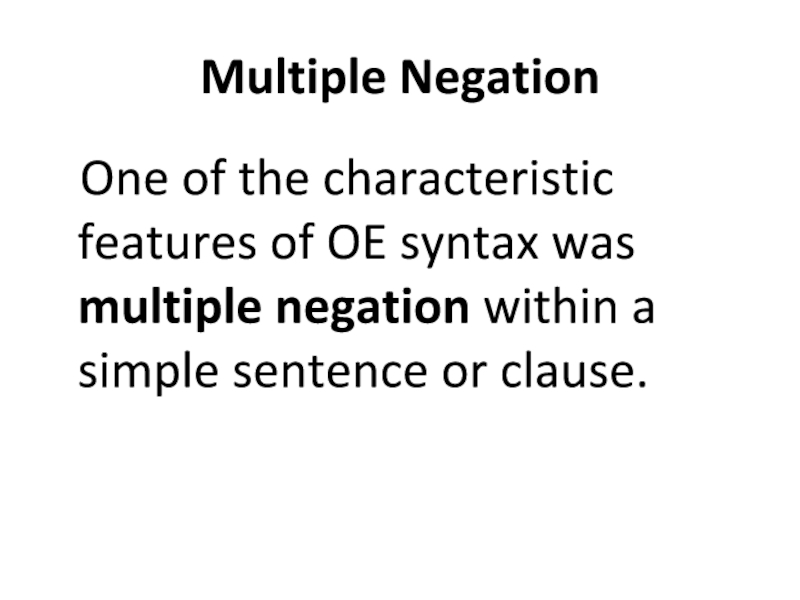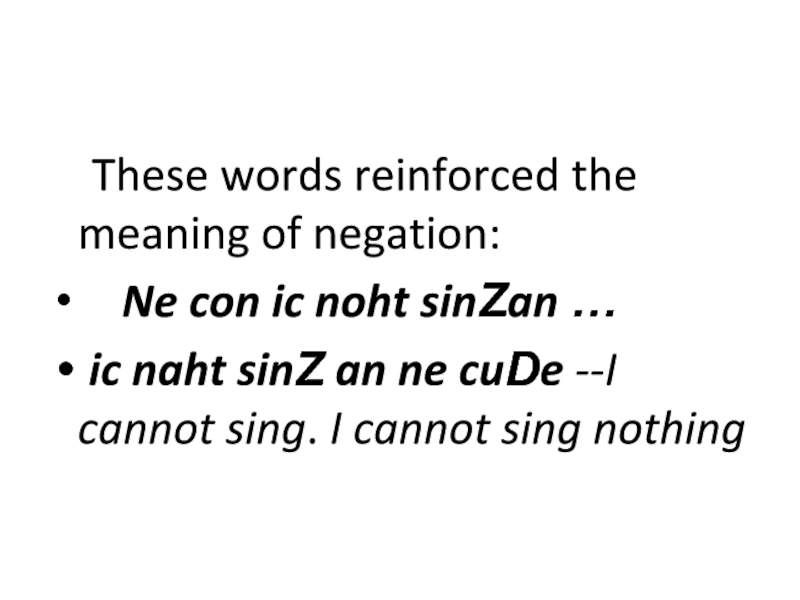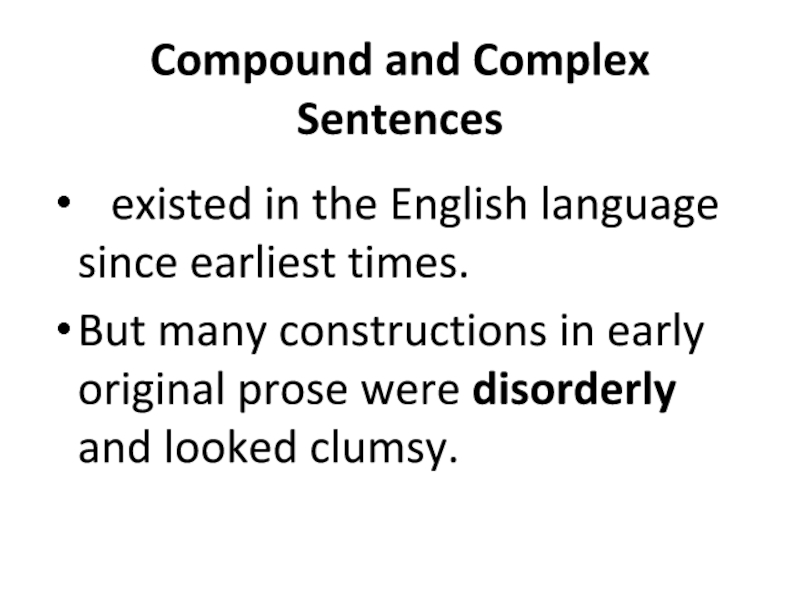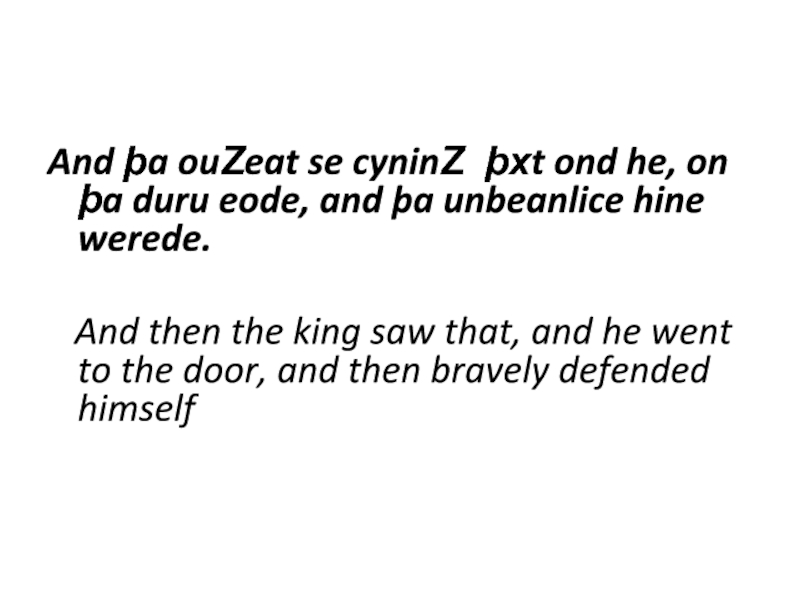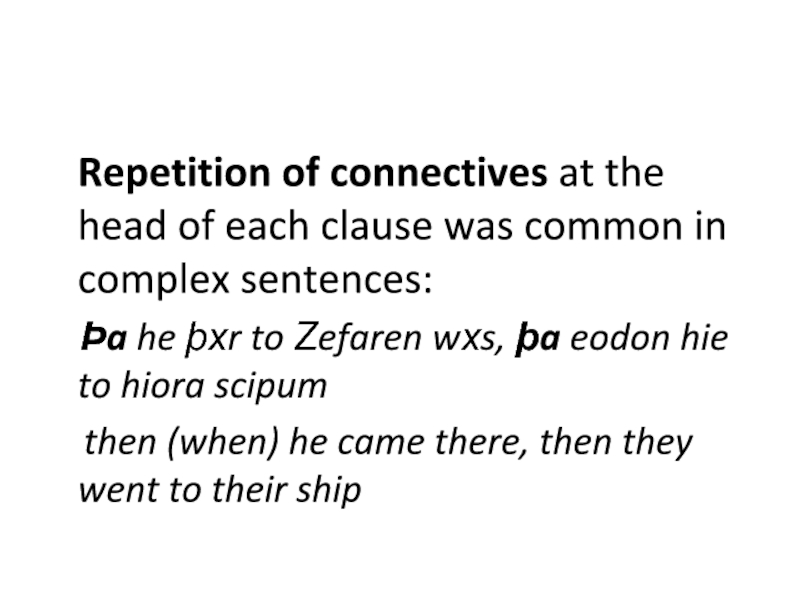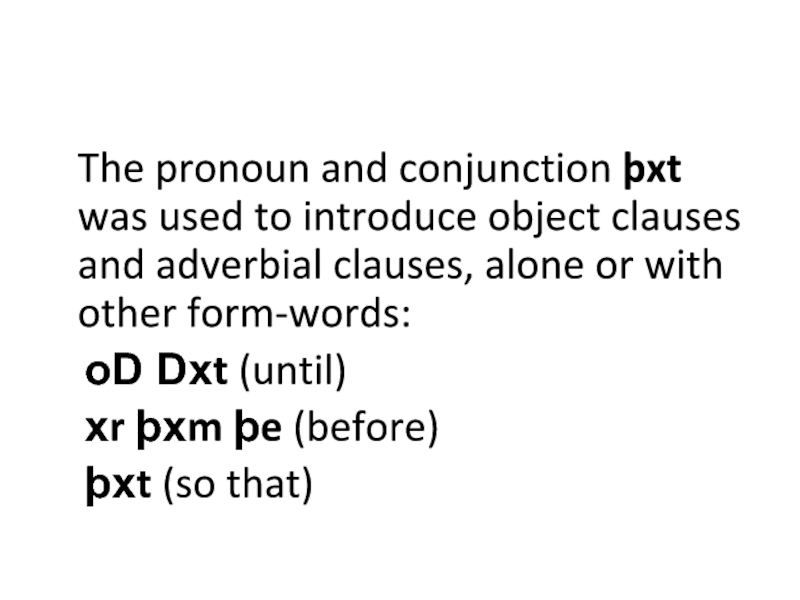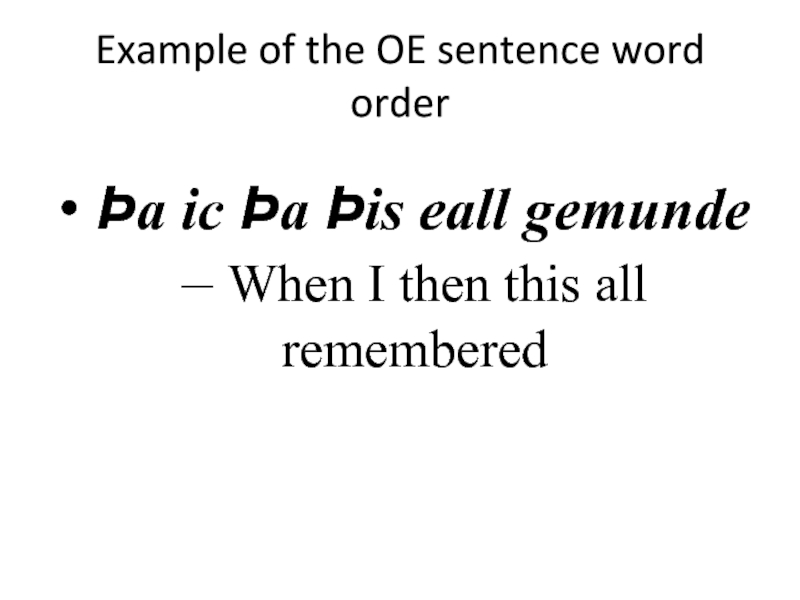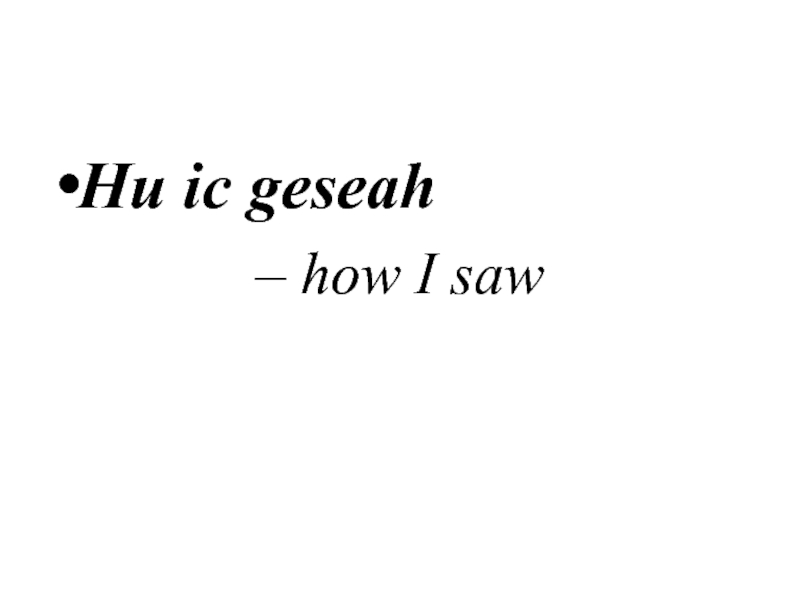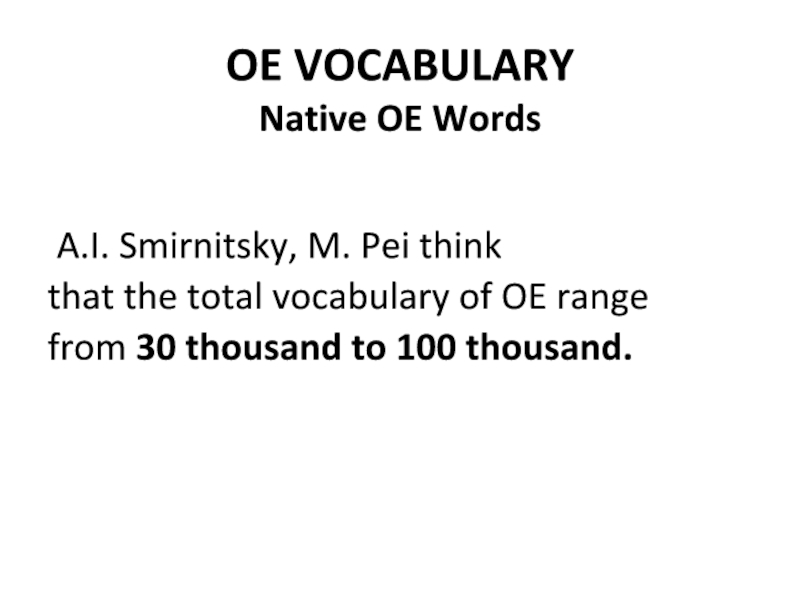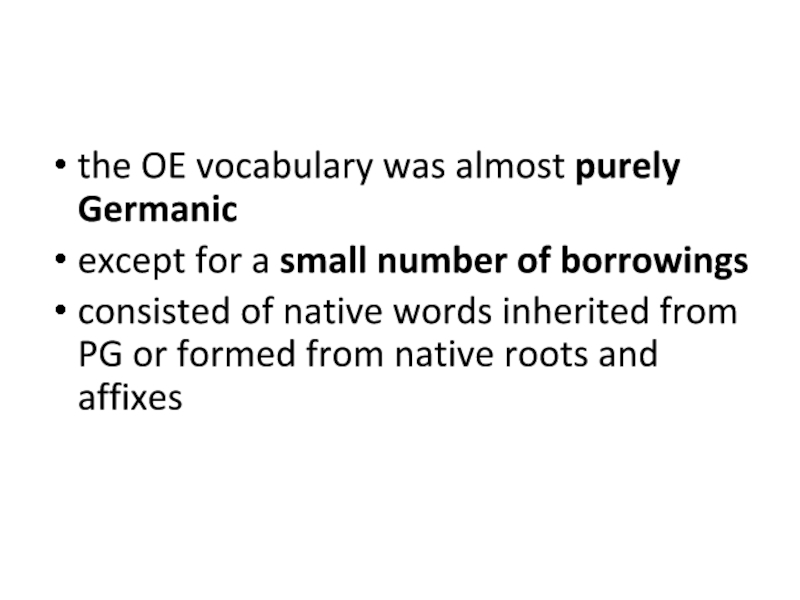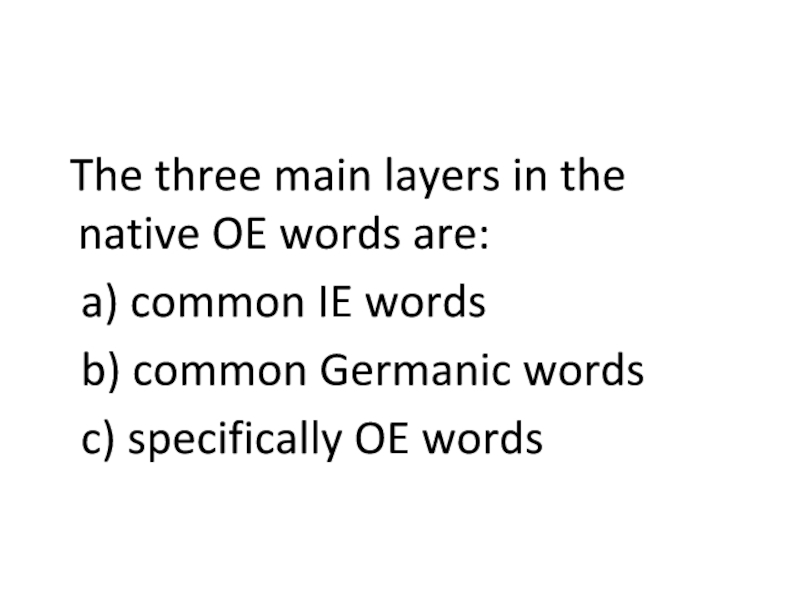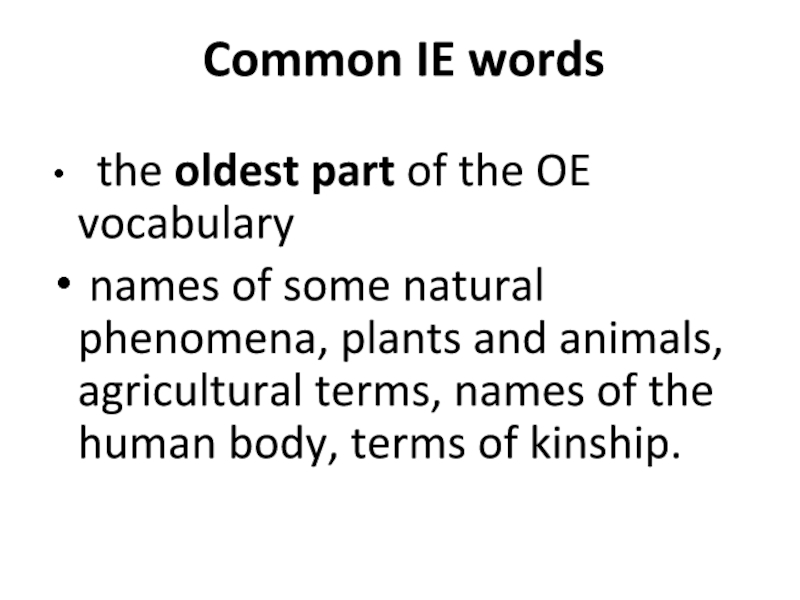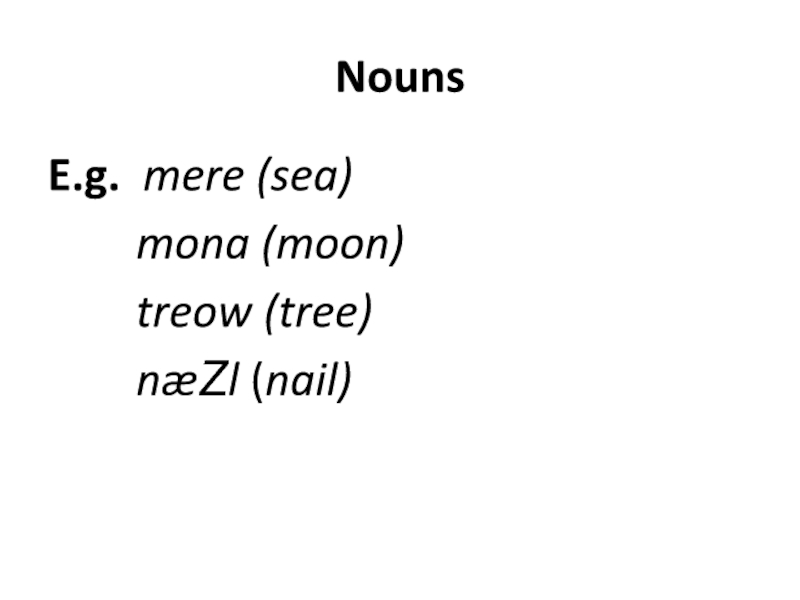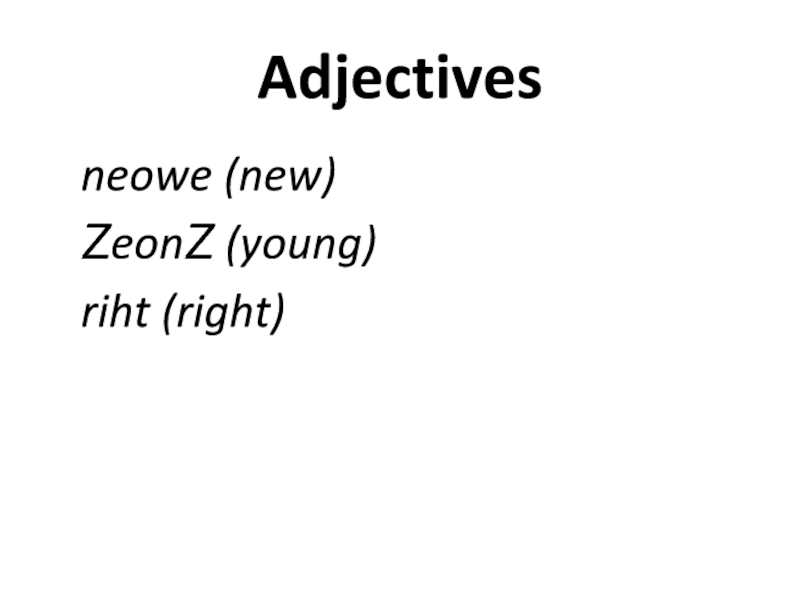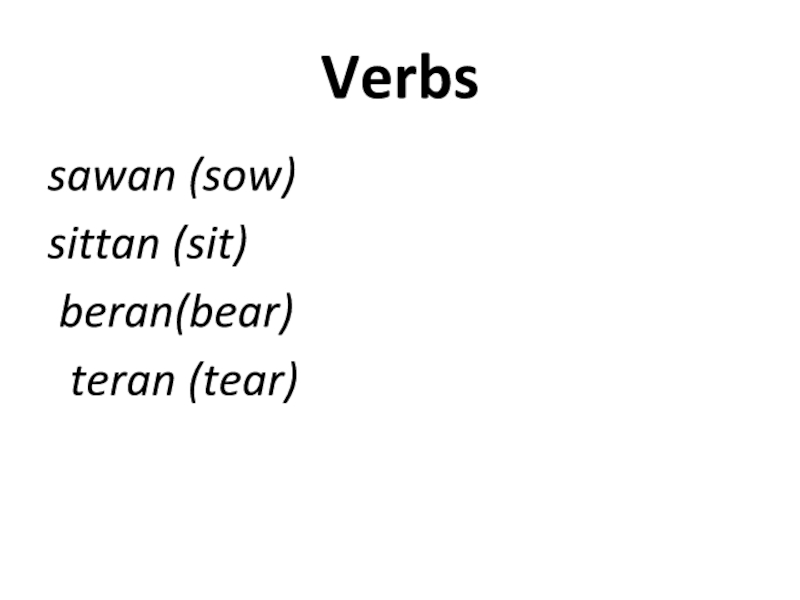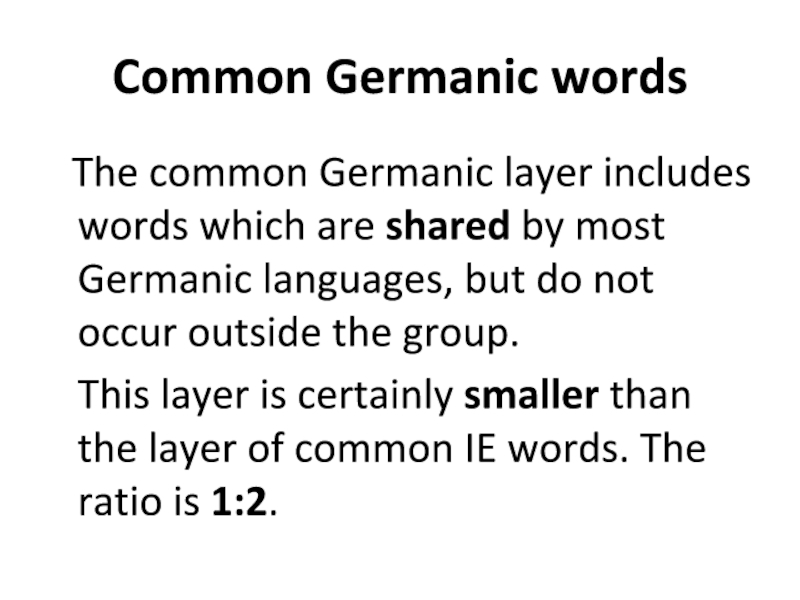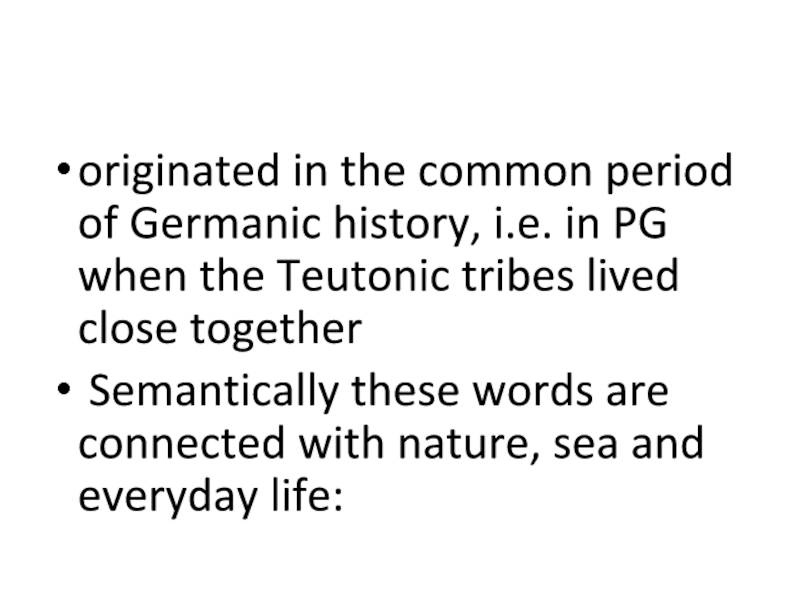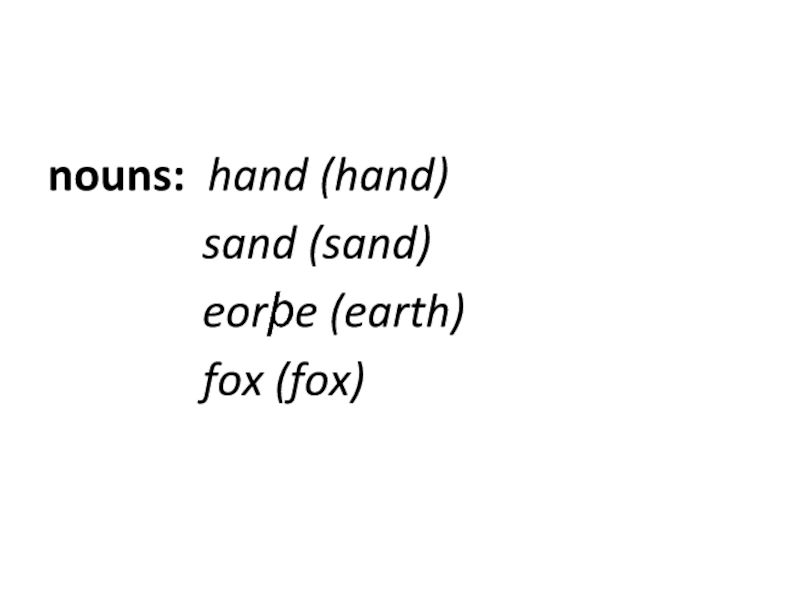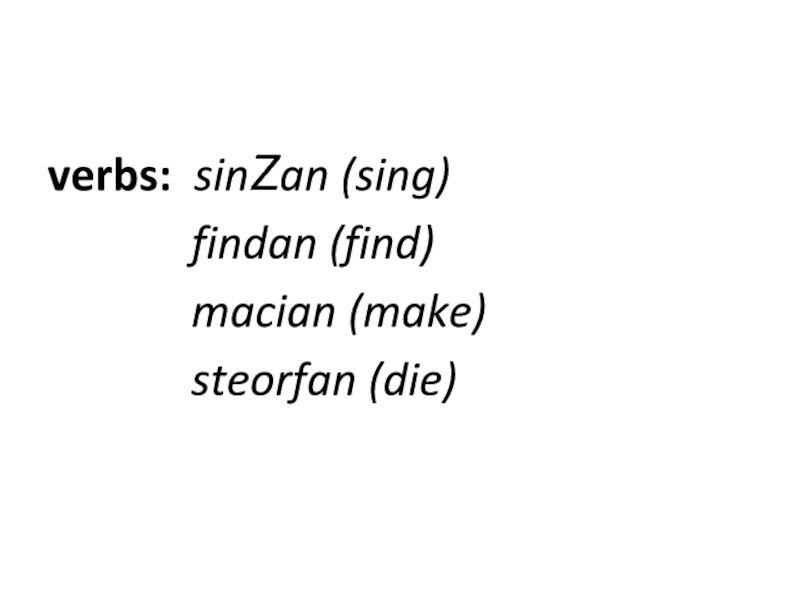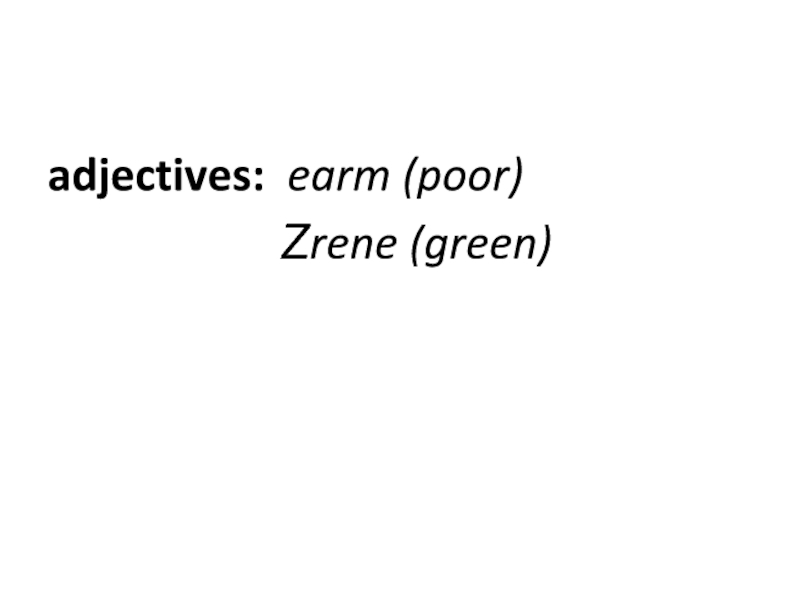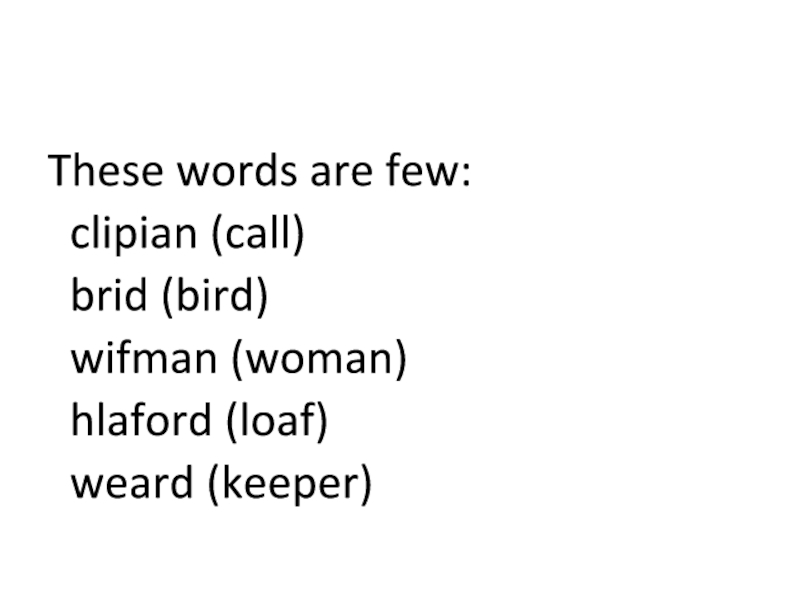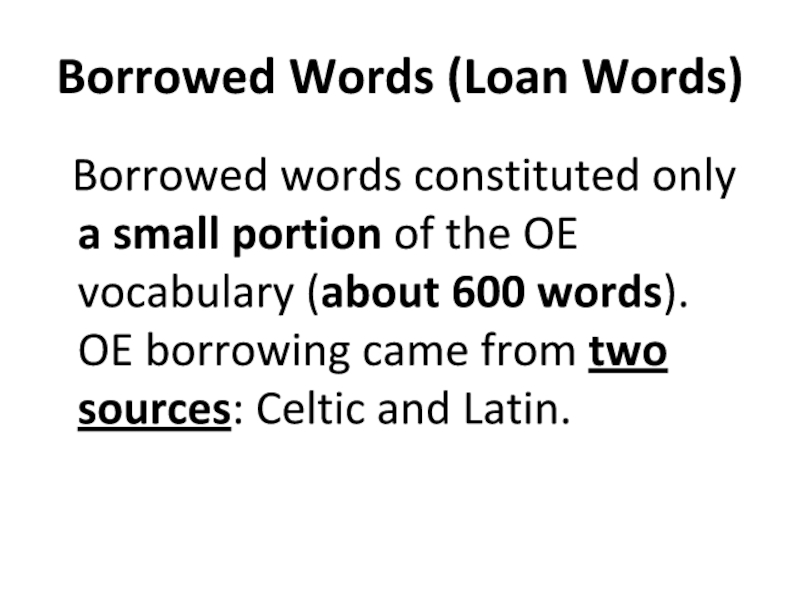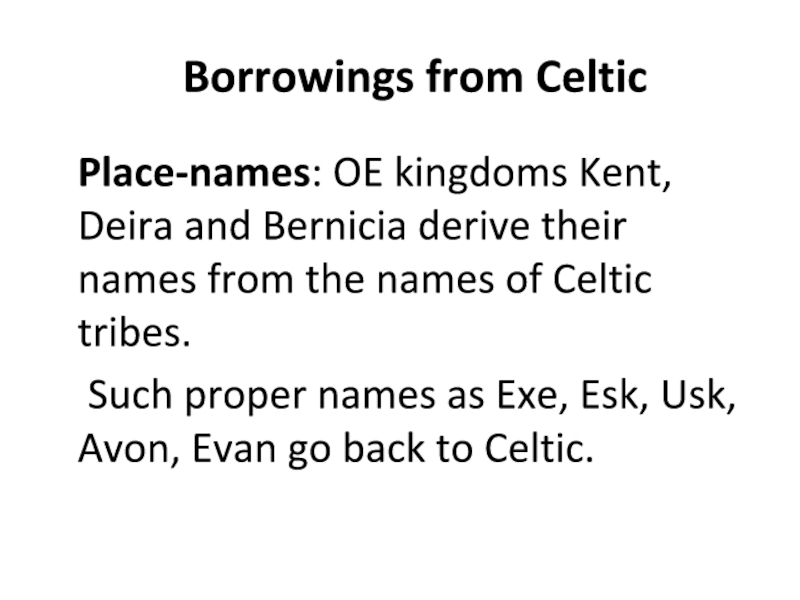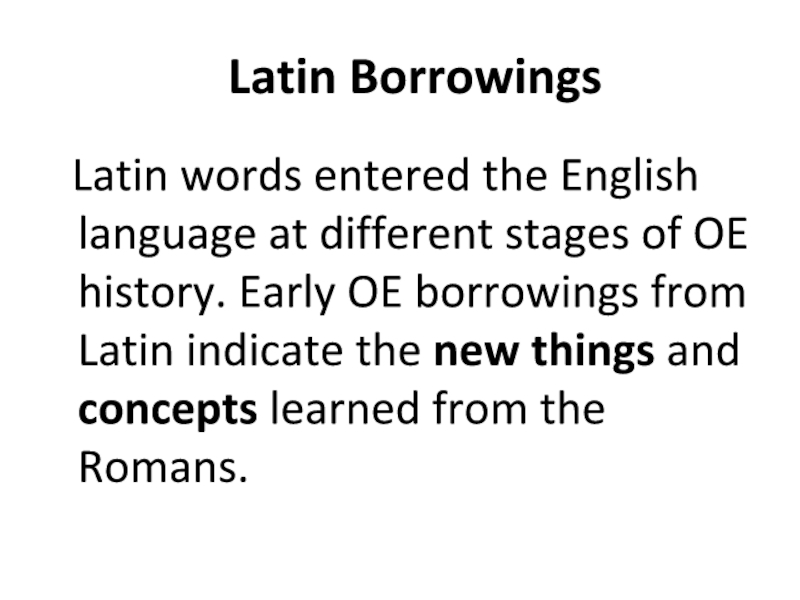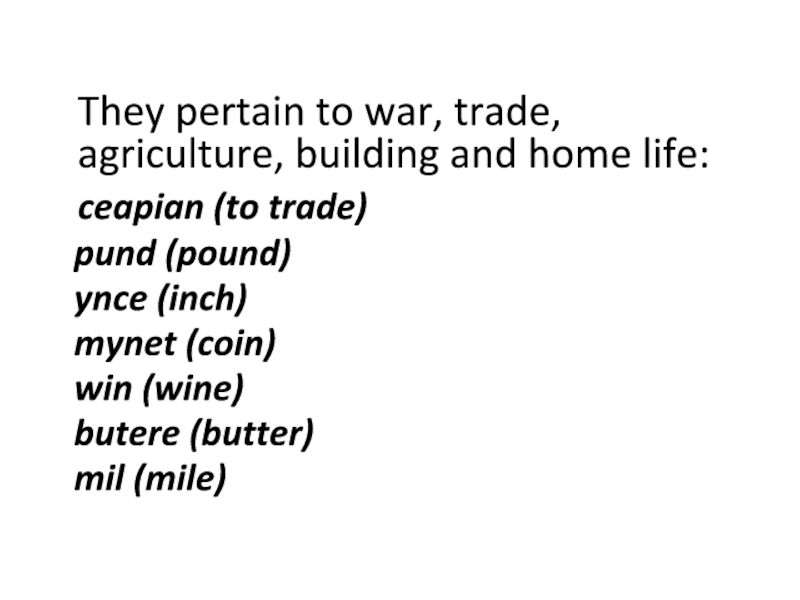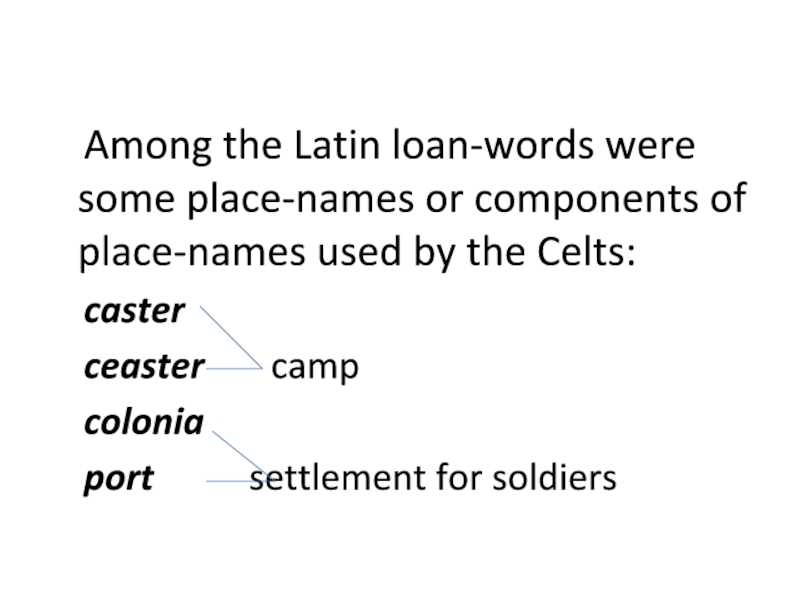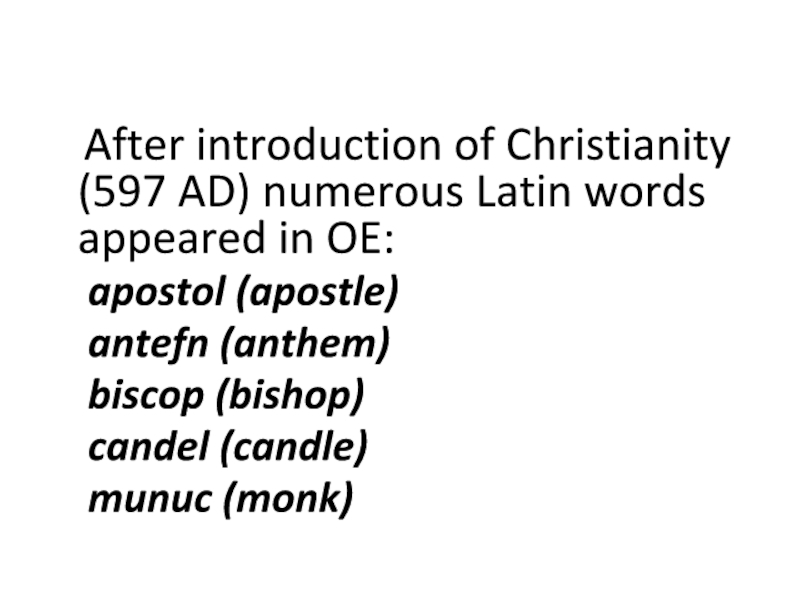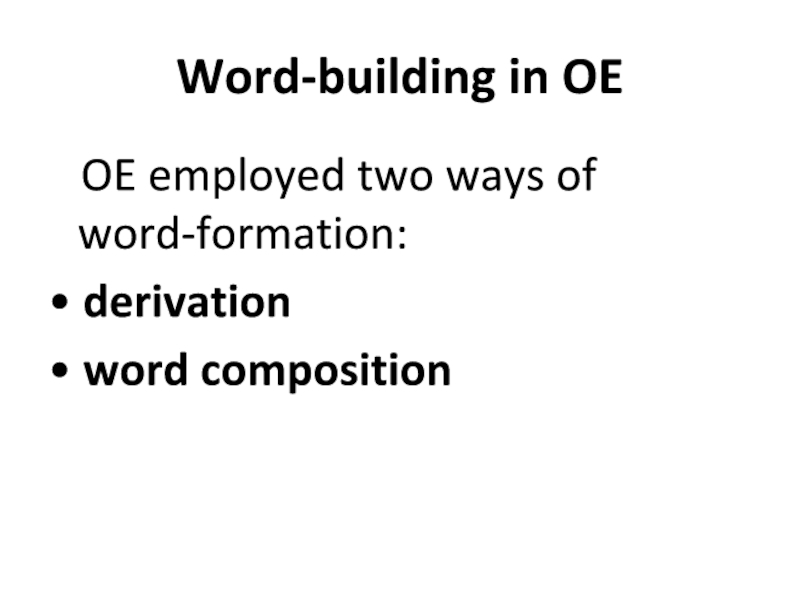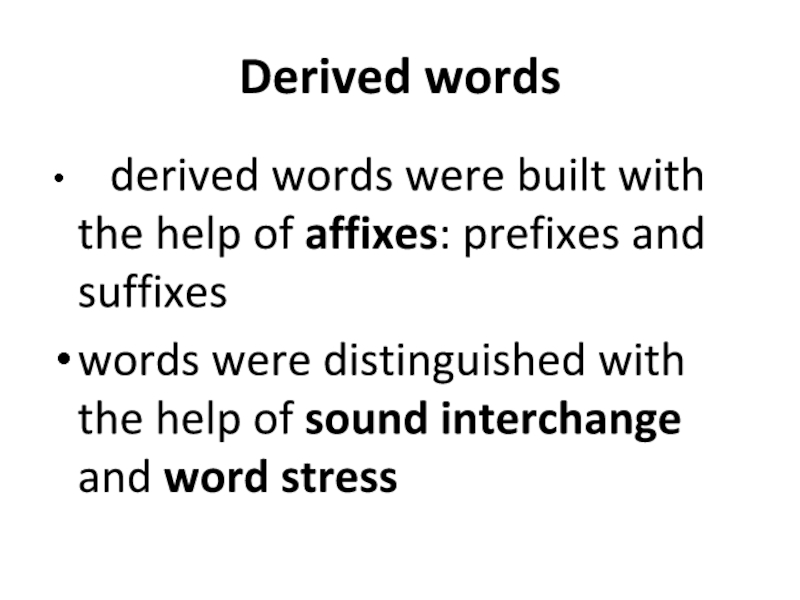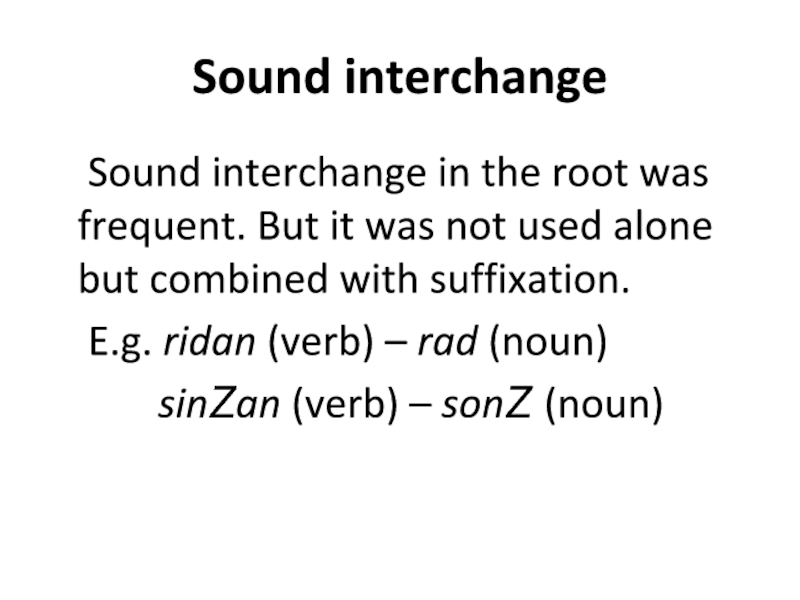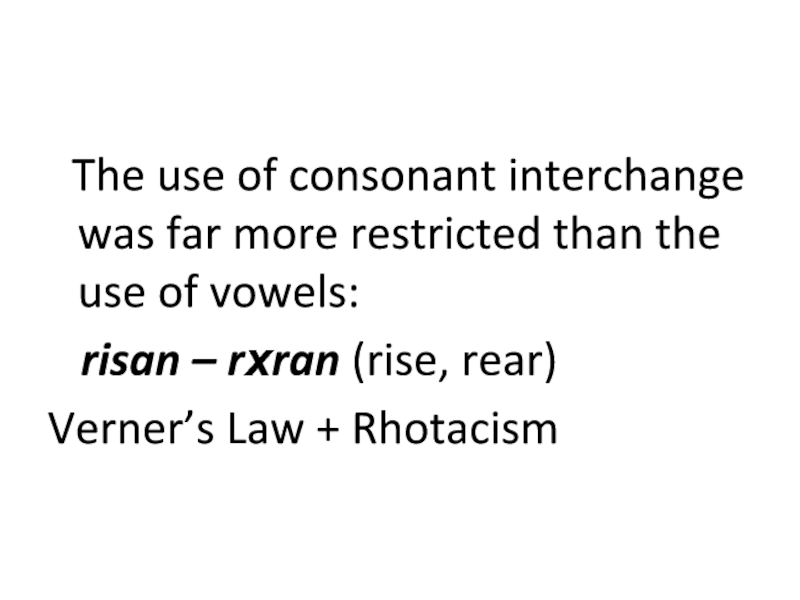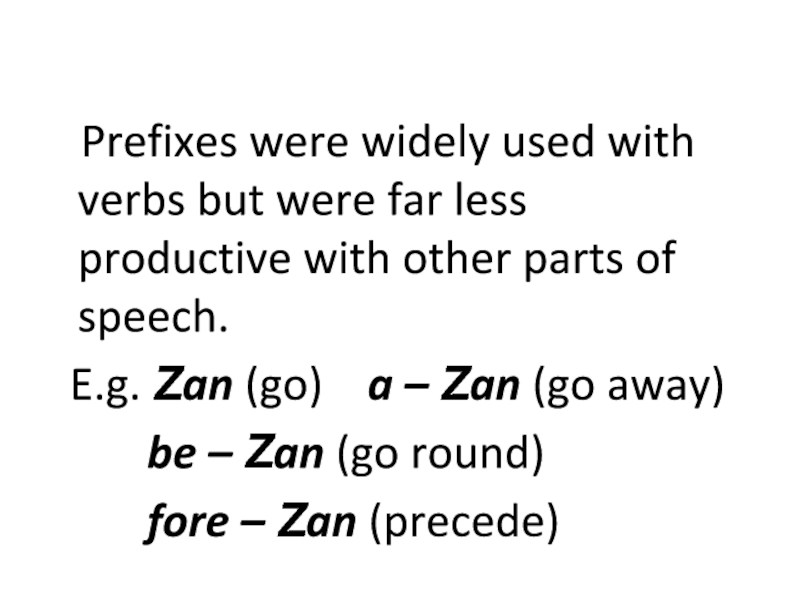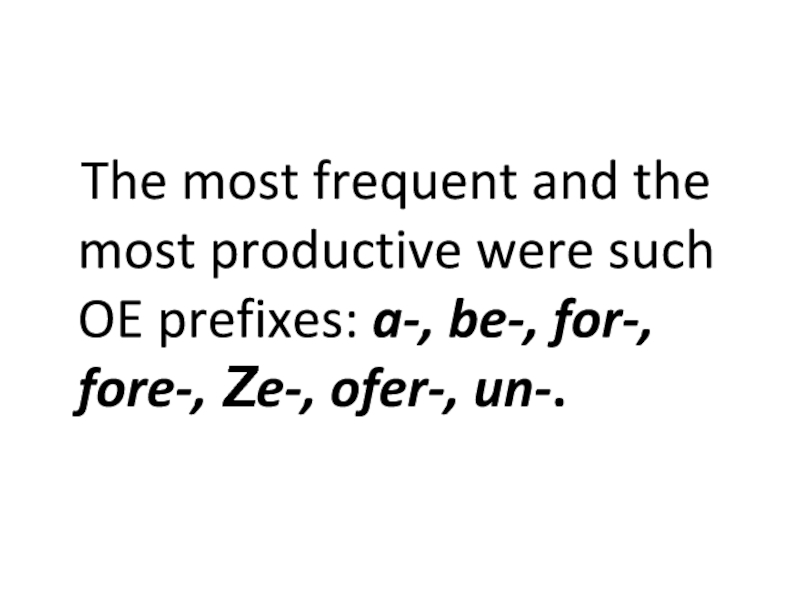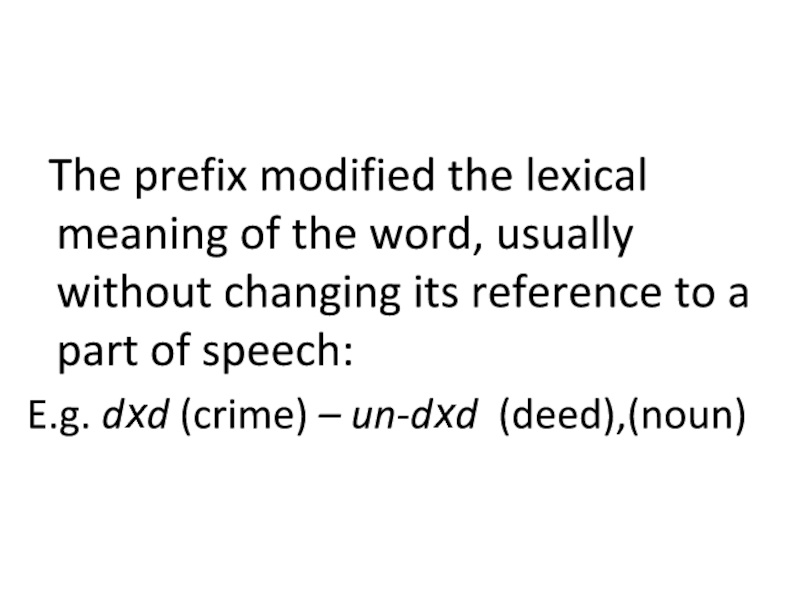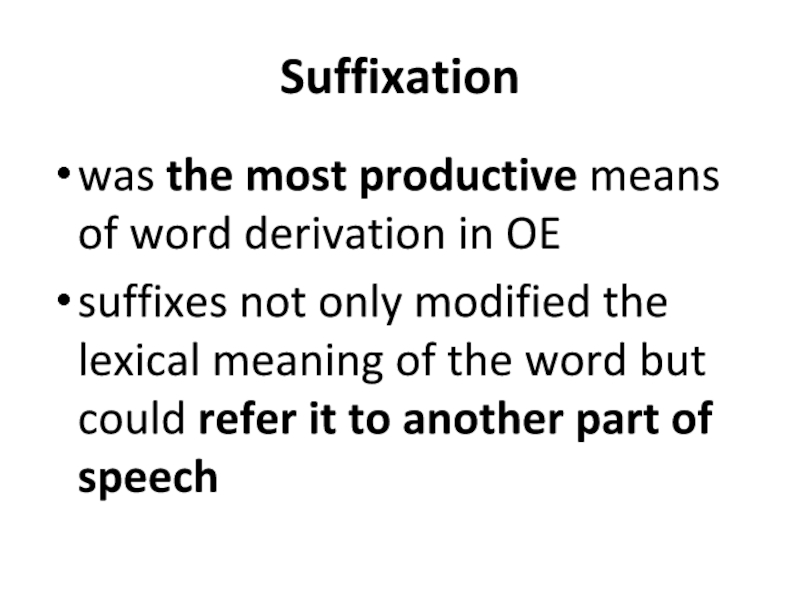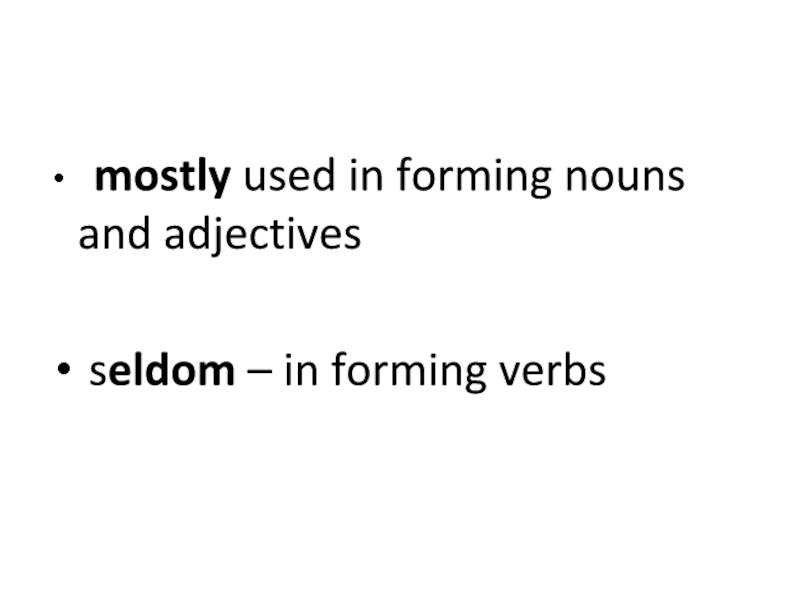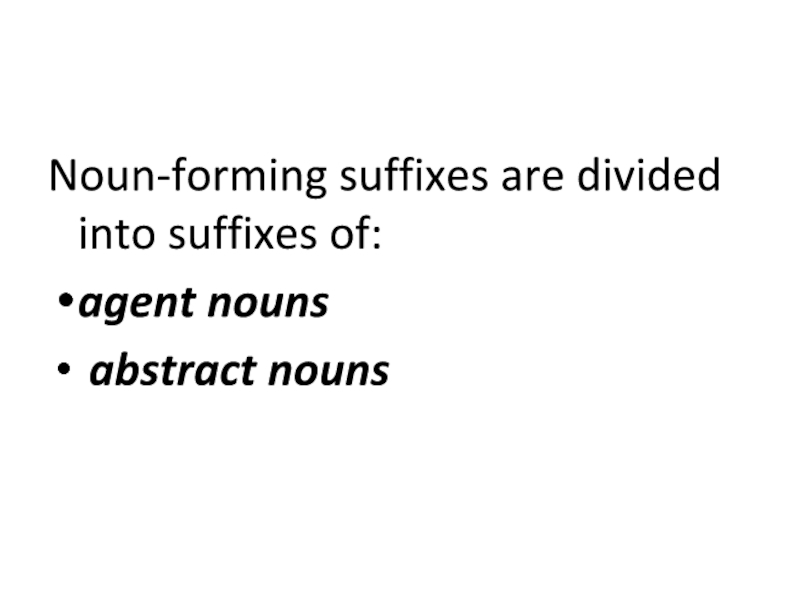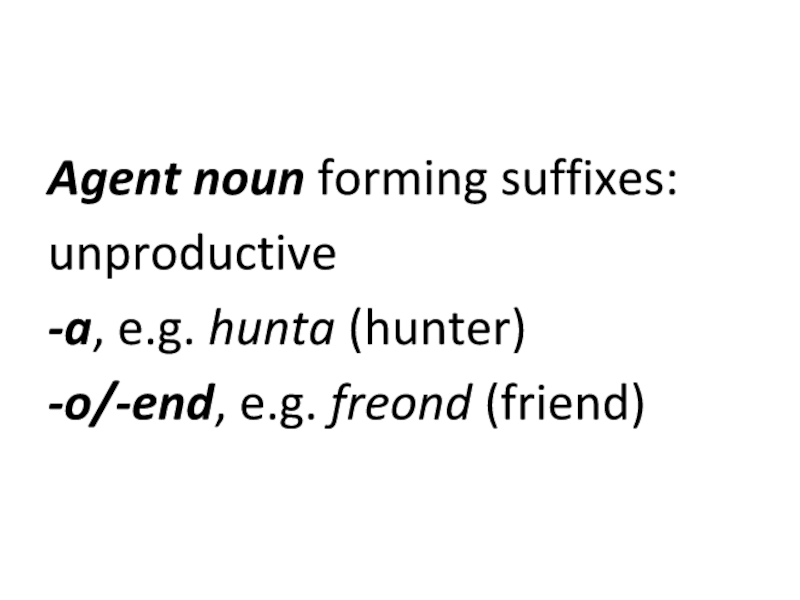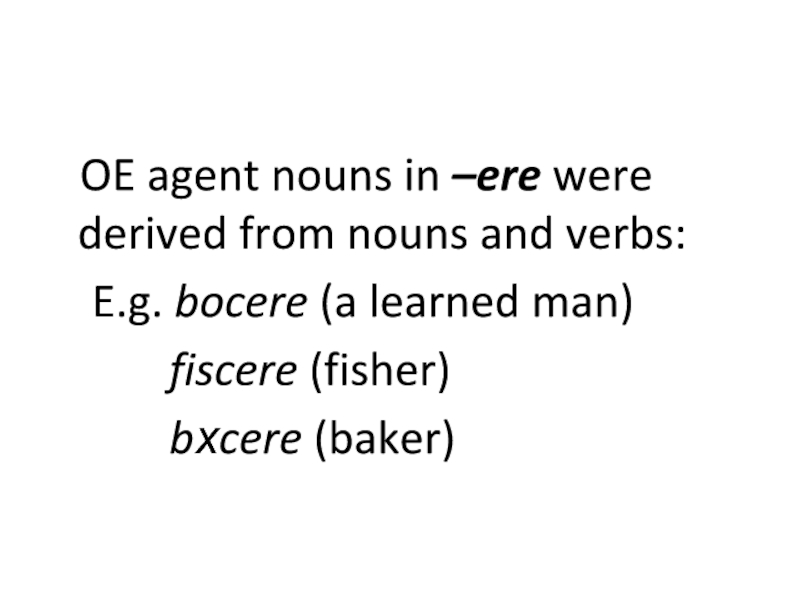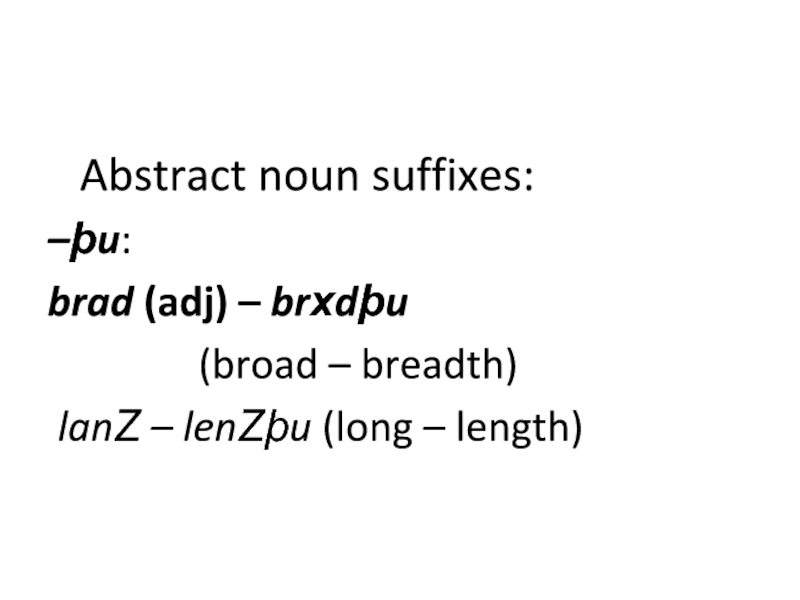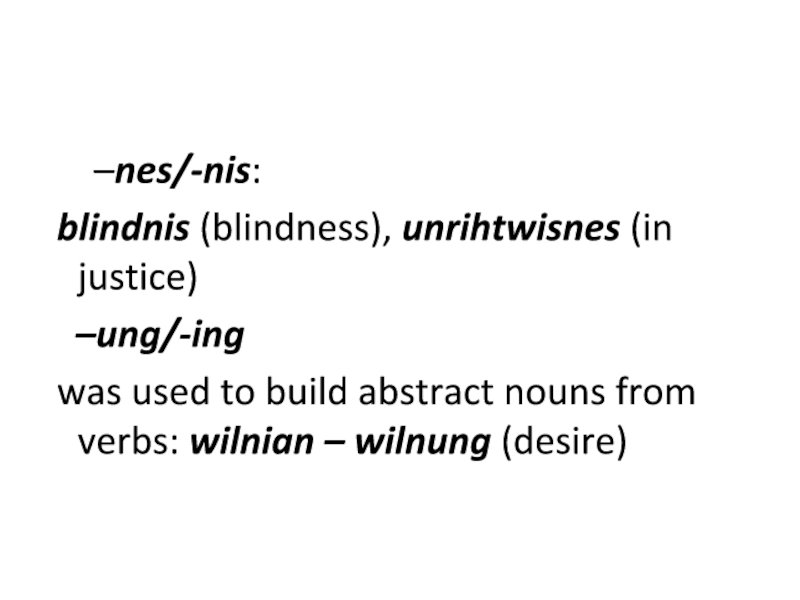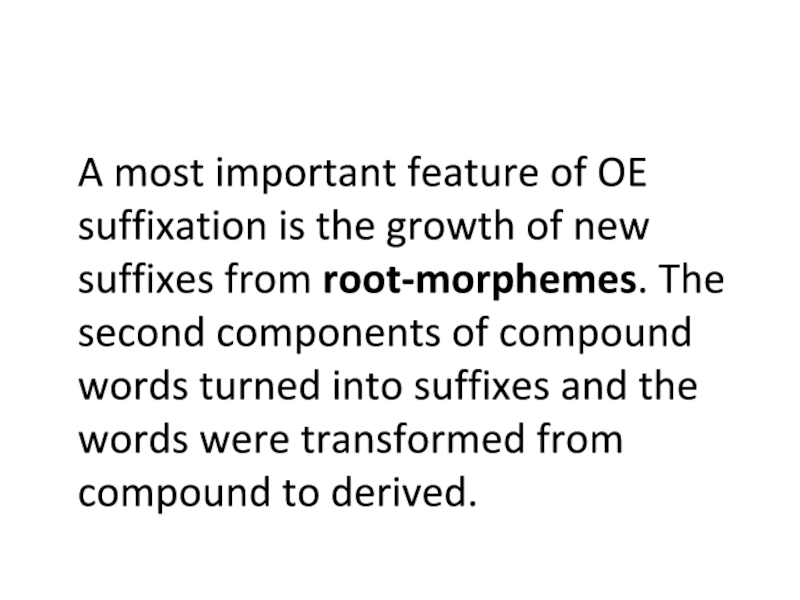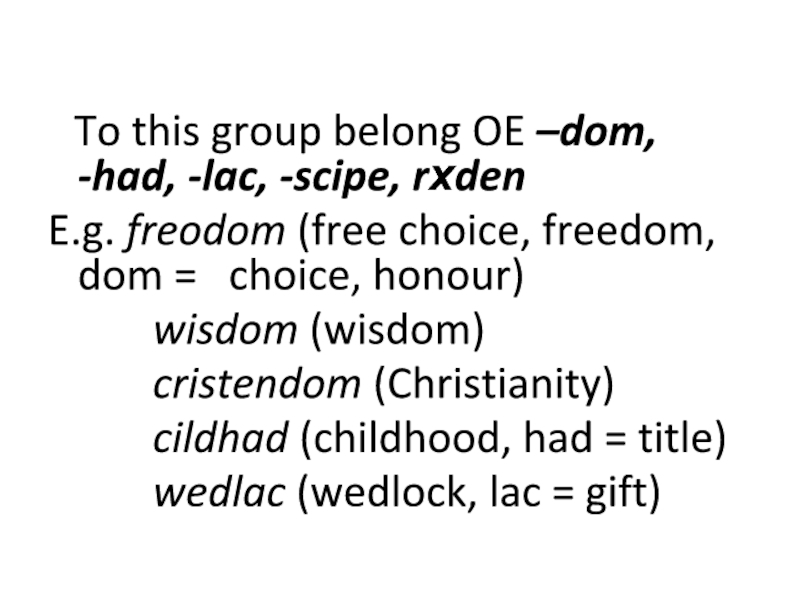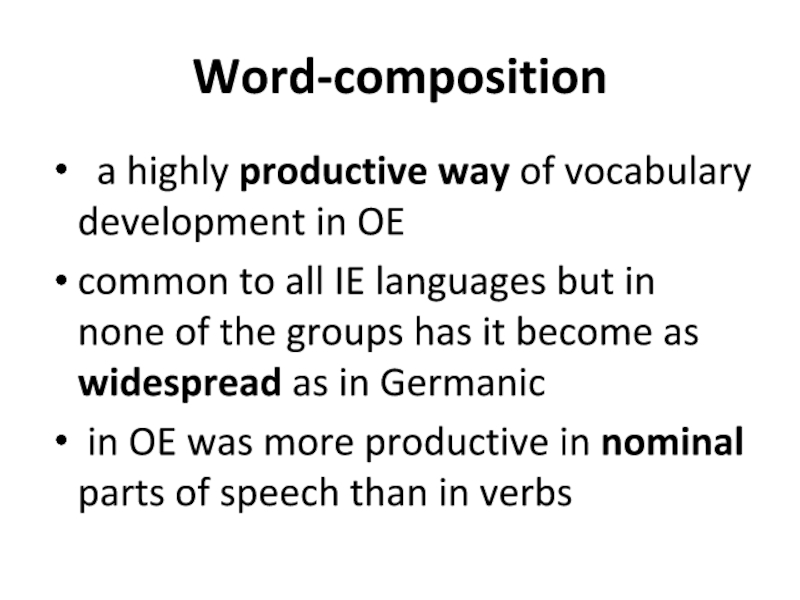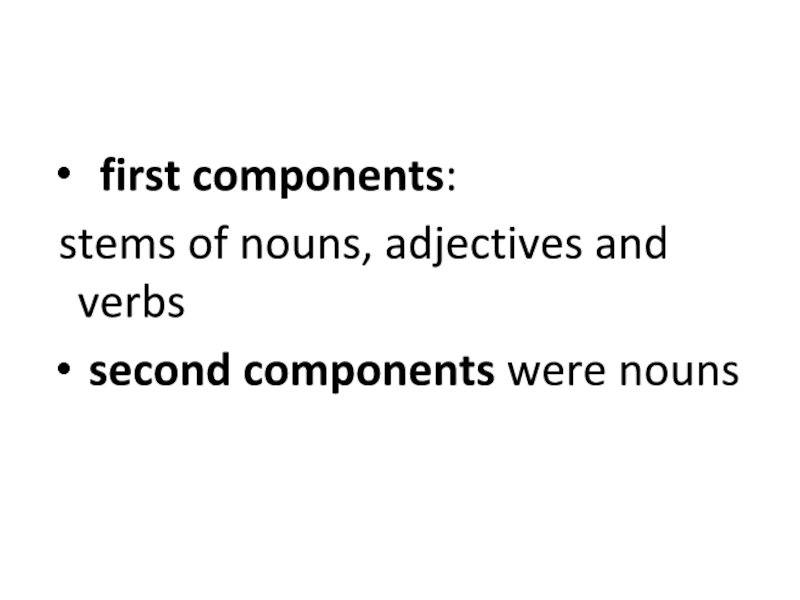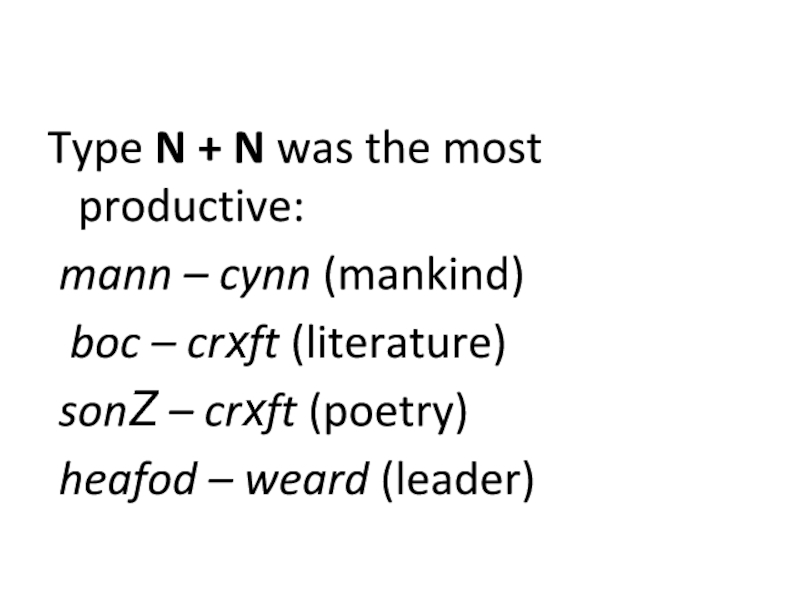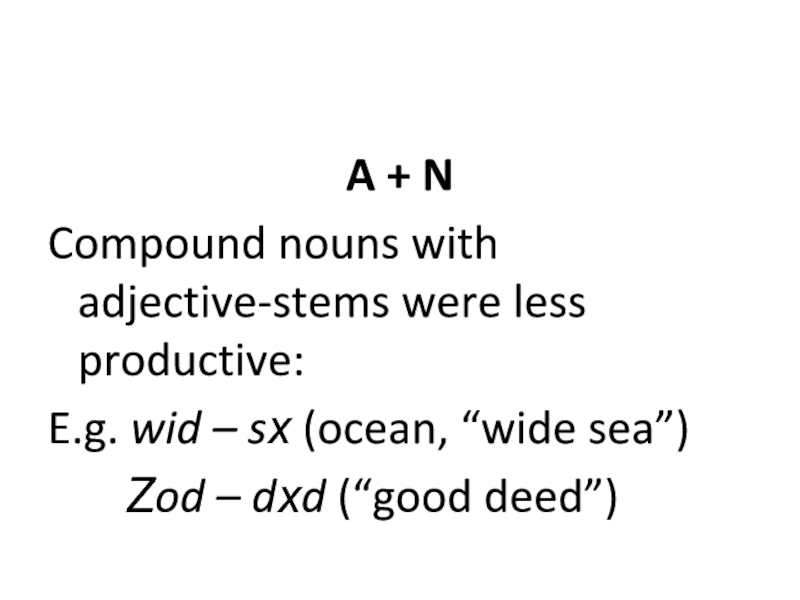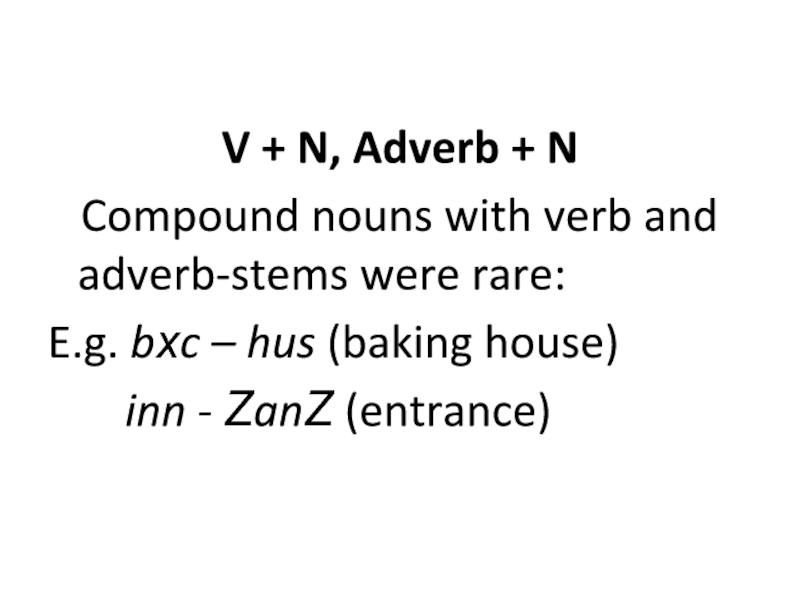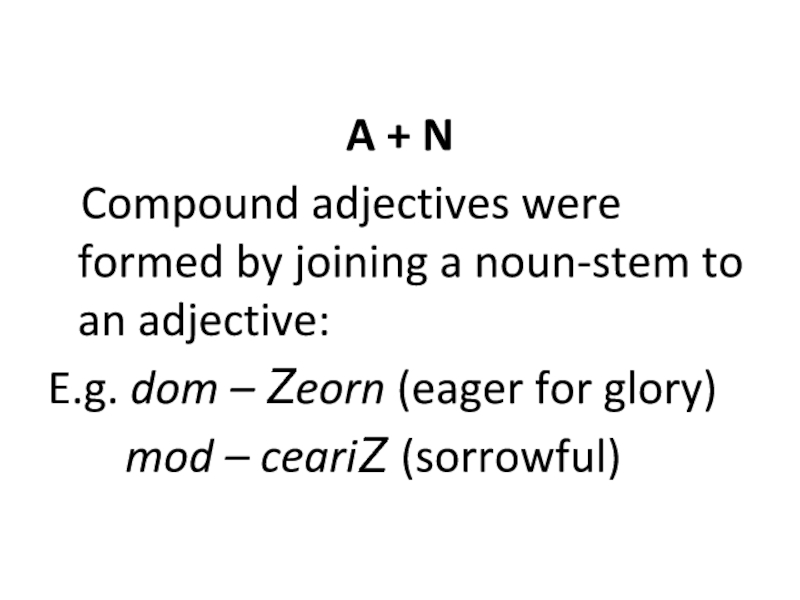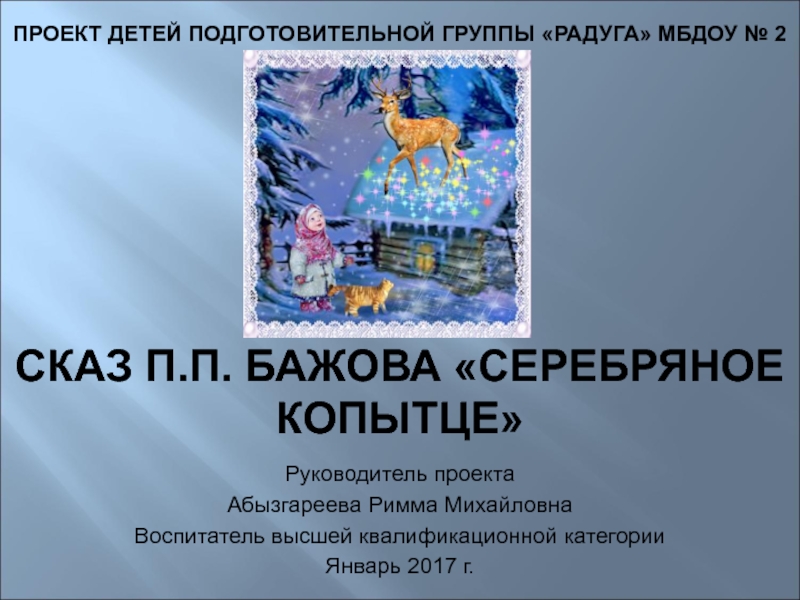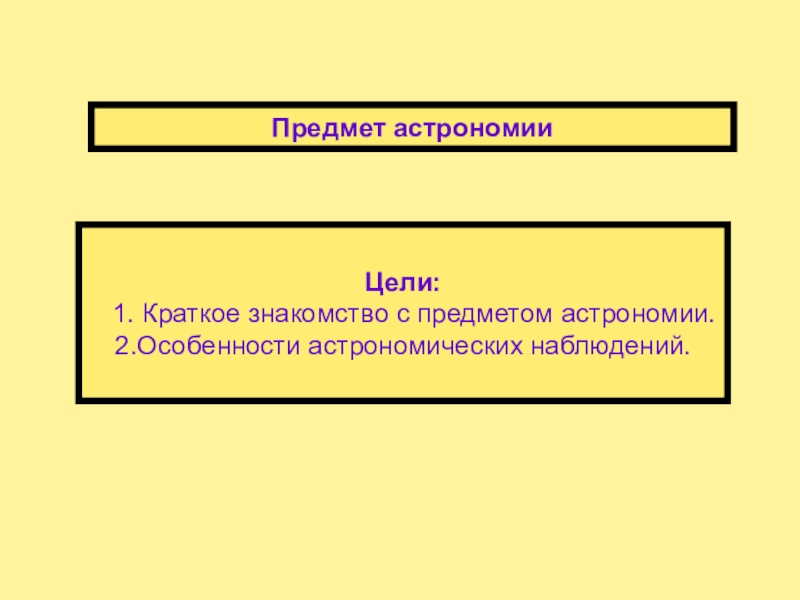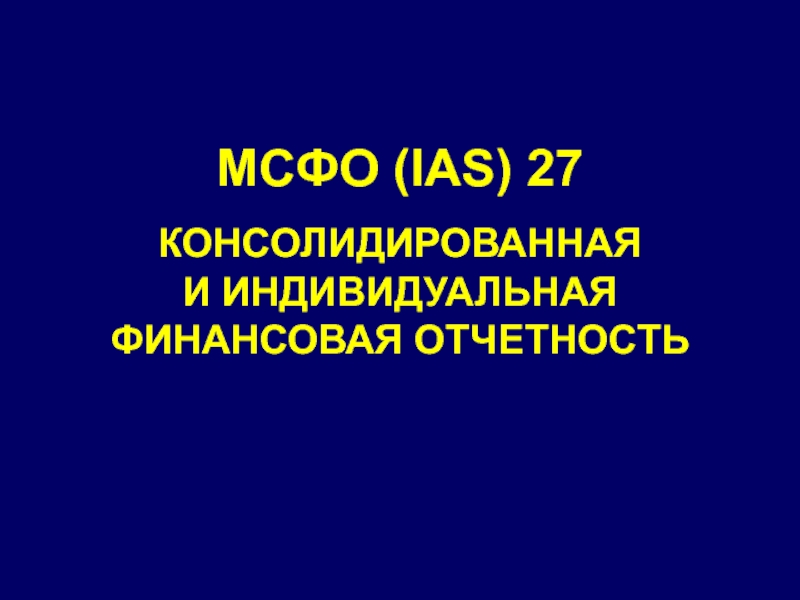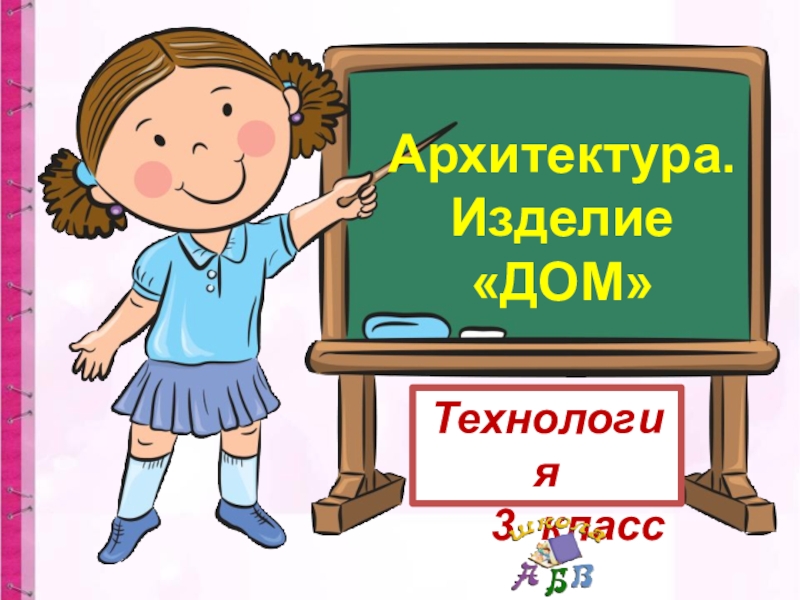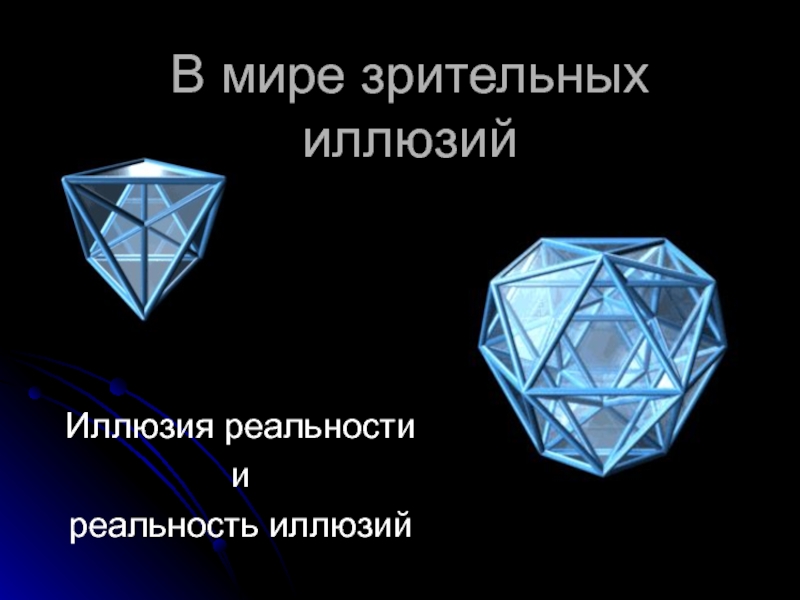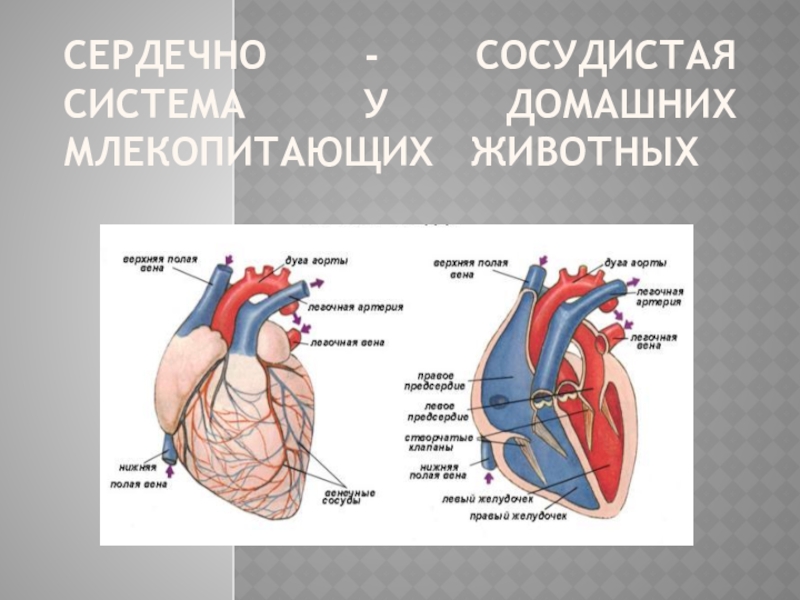Разделы презентаций
- Разное
- Английский язык
- Астрономия
- Алгебра
- Биология
- География
- Геометрия
- Детские презентации
- Информатика
- История
- Литература
- Математика
- Медицина
- Менеджмент
- Музыка
- МХК
- Немецкий язык
- ОБЖ
- Обществознание
- Окружающий мир
- Педагогика
- Русский язык
- Технология
- Физика
- Философия
- Химия
- Шаблоны, картинки для презентаций
- Экология
- Экономика
- Юриспруденция
OE SYNTAX The order of sentence elements
Содержание
- 1. OE SYNTAX The order of sentence elements
- 2. In Germanic the order of
- 3. the word order of sentence elements
- 4. AVSO order E.g.: Þa cwxD sum oDer deofol – then said another devil
- 5. in Germanic the object had a
- 6. .
- 7. But if the verb consisted
- 8. in subordinate clauses the verb
- 9. Because of these variations there
- 10. It was not a verb-second
- 11. Multiple Negation One of
- 12. The most common negative particle
- 13. These words reinforced the meaning
- 14. Compound and Complex Sentences
- 15. Coordinate clauses were mostly joined
- 16. And þa ouZeat se cyninZ þxt ond
- 17. Repetition of connectives at the
- 18. The pronoun and conjunction þxt
- 19. Some clauses were joined asyndetically.
- 20. Example of the OE sentence word order
- 21. Þa gemunde ic eac – then remembered I also
- 22. Hu ic geseah– how I saw
- 23. xr Þxm Þe hit eall forhergod wxre
- 24. hu Þa circicean giond eall Angelcynn stodon
- 25. OE VOCABULARY Native OE Words
- 26. the OE vocabulary was almost purely Germanicexcept
- 27. Native OE words Native OE words
- 28. The three main layers in the
- 29. Common IE words the oldest part
- 30. NounsE.g. mere (sea) mona
- 31. Adjectives neowe (new) ZeonZ (young) riht (right)
- 32. Verbssawan (sow)sittan (sit) beran(bear) teran (tear)
- 33. Common Germanic words The common Germanic
- 34. originated in the common period of Germanic
- 35. nouns: hand (hand)
- 36. verbs: sinZan (sing)
- 37. adjectives: earm (poor) Zrene (green)
- 38. Specifically OE words are words which do not occur in other Germanic or non-Germanic languages.
- 39. These words are few: clipian (call) brid (bird) wifman (woman) hlaford (loaf) weard (keeper)
- 40. Borrowed Words (Loan Words) Borrowed words
- 41. Borrowings from Celtic Place-names:
- 42. Many place-names with Celtic elements are hybrids:
- 43. Latin Borrowings Latin words
- 44. They pertain to war, trade,
- 45. Among the Latin loan-words were
- 46. After introduction of Christianity (597
- 47. Word-building in OE OE employed two ways of word-formation: derivation word composition
- 48. Derived words derived words were built
- 49. Sound interchange Sound interchange in the
- 50. The use of consonant interchange
- 51. Prefixation a productive way of building new
- 52. Prefixes were widely used with
- 53. The most frequent and the
- 54. The prefix modified the lexical meaning
- 55. Suffixationwas the most productive means of word
- 56. mostly used in forming nouns and adjectives seldom – in forming verbs
- 57. Noun-forming suffixes are divided into suffixes of: agent nouns abstract nouns
- 58. Agent noun forming suffixes:unproductive -a, e.g. hunta (hunter)-o/-end, e.g. freond (friend)
- 59. OE agent nouns in –ere
- 60. nouns in –ere were masculinethe corresponding
- 61. Suffix –inZ was used to build patronymics
- 62. Abstract noun suffixes:–þu: brad (adj)
- 63. –nes/-nis: blindnis (blindness), unrihtwisnes
- 64. A most important feature of
- 65. To this group belong
- 66. Word-composition a highly productive way of vocabulary
- 67. first components: stems of nouns, adjectives and verbs second components were nouns
- 68. Type N + N was the most
- 69. A + N Compound nouns with
- 70. V + N, Adverb + N
- 71. A + N Compound adjectives were
- 72. Скачать презентанцию
In Germanic the order of sentence elements was usually SOV ( the subject – the verb – the object)
Слайды и текст этой презентации
Слайд 2 In Germanic the order of sentence elements was
usually SOV ( the subject – the verb – the
object)Слайд 3 the word order of sentence elements in OE is
mixed
there was a tendency to put the verb in second
position: SVO orderexcept that when an adverbial modifier came at the beginning of a sentence
Слайд 5 in Germanic the object had a tendency to precede
the verb
in OE this was no longer the case,
and very often the object followed the verb either directly or after the subject Слайд 7 But if the verb consisted of an auxiliary
element and infinitive or participle the order was S –
aux – OV: we sceolon eac Cristes acennednysse … wurDian(we must also honour Christ’s birth)
Слайд 8 in subordinate clauses the verb was commonly placed
at the end of the clause:
þxt hi heora lare
Zymon(that they attended to their instruction)
Слайд 9 Because of these variations there is a dispute
among scholars what the precise word-order patterns were in OE.
Слайд 10 It was not a verb-second language and it
did not retain the SOV order. OE was in transitional
stage moving from SOV to SVO, though with a preference for AVSO.Слайд 11
Multiple Negation
One of the characteristic features of OE
syntax was multiple negation within a simple sentence or clause.
Слайд 12 The most common negative particle was ne.
It
was placed before the verband was often accompanied by other
negative words: naht or noht.Слайд 13 These words reinforced the meaning of negation:
Ne con ic noht sinZan …
ic naht sinZ an
ne cuDe --I cannot sing. I cannot sing nothingСлайд 14
Compound and Complex Sentences
existed in the English language
since earliest times.
But many constructions in early original prose
were disorderly and looked clumsy.Слайд 15
Coordinate clauses were mostly joined by and, a
conjunction of a most general meaning. E. g.:
Слайд 16And þa ouZeat se cyninZ þxt ond he, on þa
duru eode, and þa unbeanlice hine werede.
And
then the king saw that, and he went to the door, and then bravely defended himselfСлайд 17 Repetition of connectives at the head of each
clause was common in complex sentences:
Þa he þxr
to Zefaren wxs, þa eodon hie to hiora scipumthen (when) he came there, then they went to their ship
Слайд 18 The pronoun and conjunction þxt was used to
introduce object clauses and adverbial clauses, alone or with other
form-words:oD Dxt (until)
xr þxm þe (before)
þxt (so that)
Слайд 20Example of the OE sentence word order
Þa ic Þa
Þis eall gemunde – When I then this all
rememberedСлайд 24hu Þa circicean giond eall Angelcynn stodon ma Þma and
boca gefylda
– how the churches throughout all England stood
with treasures and books filled Слайд 25
OE VOCABULARY
Native OE Words
A.I. Smirnitsky, M. Pei
think
that the total vocabulary of OE range
from 30
thousand to 100 thousand. Слайд 26the OE vocabulary was almost purely Germanic
except for a small
number of borrowings
consisted of native words inherited from PG
or formed from native roots and affixesСлайд 27Native OE words
Native OE words can be subdivided
into a number of etymological layers coming from different historical
periods.Слайд 28 The three main layers in the native OE words
are:
a) common IE words
b) common Germanic
wordsc) specifically OE words
Слайд 29Common IE words
the oldest part of the OE vocabulary
names of some natural phenomena, plants and animals, agricultural terms,
names of the human body, terms of kinship.Слайд 33Common Germanic words
The common Germanic layer includes words
which are shared by most Germanic languages, but do not
occur outside the group.This layer is certainly smaller than the layer of common IE words. The ratio is 1:2.
Слайд 34originated in the common period of Germanic history, i.e. in
PG when the Teutonic tribes lived close together
Semantically these
words are connected with nature, sea and everyday life:Слайд 38Specifically OE words
are words which do not occur in
other Germanic or non-Germanic languages.
Слайд 39These words are few:
clipian (call)
brid (bird)
wifman (woman)
hlaford (loaf)
weard (keeper)
Слайд 40Borrowed Words (Loan Words)
Borrowed words constituted only a
small portion of the OE vocabulary (about 600 words). OE
borrowing came from two sources: Celtic and Latin.Слайд 41
Borrowings from Celtic
Place-names: OE kingdoms Kent, Deira and
Bernicia derive their names from the names of Celtic tribes.
Such proper names as Exe, Esk, Usk, Avon, Evan go back to Celtic.Слайд 43
Latin Borrowings
Latin words entered the English language at
different stages of OE history. Early OE borrowings from Latin
indicate the new things and concepts learned from the Romans.Слайд 44 They pertain to war, trade, agriculture, building and
home life:
ceapian (to trade)
pund (pound)
ynce (inch)mynet (coin)
win (wine)
butere (butter)
mil (mile)
Слайд 45 Among the Latin loan-words were some place-names or
components of place-names used by the Celts:
caster
ceaster campcolonia
port settlement for soldiers
Слайд 46 After introduction of Christianity (597 AD) numerous Latin
words appeared in OE:
apostol (apostle)
antefn (anthem)
biscop (bishop)candel (candle)
munuc (monk)
Слайд 48Derived words
derived words were built with the help
of affixes: prefixes and suffixes
words were distinguished with the help
of sound interchange and word stressСлайд 49Sound interchange
Sound interchange in the root was frequent.
But it was not used alone but combined with suffixation.
E.g. ridan (verb) – rad (noun)sinZan (verb) – sonZ (noun)
Слайд 50 The use of consonant interchange was far more
restricted than the use of vowels:
risan – rxran
(rise, rear) Verner’s Law + Rhotacism
Слайд 51Prefixation
a productive way of building new words in OE
Some OE prefixes go back to IE prototypes (un-). Many
prefixes appeared in PG: e.g. mis-, be-, ofer-Слайд 52 Prefixes were widely used with verbs but were
far less productive with other parts of speech.
E.g. Zan
(go) a – Zan (go away)be – Zan (go round)
fore – Zan (precede)
Слайд 53 The most frequent and the most productive were
such OE prefixes: a-, be-, for-, fore-, Ze-, ofer-, un-.
Слайд 54 The prefix modified the lexical meaning of the word,
usually without changing its reference to a part of speech:
E.g. dxd (crime) – un-dxd (deed),(noun)
Слайд 55Suffixation
was the most productive means of word derivation in OE
suffixes not only modified the lexical meaning of the word
but could refer it to another part of speechСлайд 58Agent noun forming suffixes:
unproductive
-a, e.g. hunta (hunter)
-o/-end,
e.g. freond (friend)
Слайд 59 OE agent nouns in –ere were derived from
nouns and verbs:
E.g. bocere (a learned man)
fiscere (fisher)
bxcere (baker)
Слайд 60 nouns in –ere were masculine
the corresponding suffix of feminine
nouns –estre was less common. E.g.:
bxcestre (female baker)
Слайд 61Suffix –inZ was used to build patronymics and to show
the descend of a person. E.g.:
CentinZ – a man coming
from KentСлайд 62 Abstract noun suffixes:
–þu:
brad (adj) – brxdþu
(broad – breadth)
lanZ
– lenZþu (long – length)Слайд 63 –nes/-nis:
blindnis (blindness), unrihtwisnes (in justice)
–ung/-ing
was used to build abstract nouns from verbs: wilnian
– wilnung (desire)Слайд 64 A most important feature of OE suffixation is
the growth of new suffixes from root-morphemes. The second components
of compound words turned into suffixes and the words were transformed from compound to derived.Слайд 65 To this group belong OE –dom, -had,
-lac, -scipe, rxden
E.g. freodom (free choice, freedom, dom =
choice, honour)wisdom (wisdom)
cristendom (Christianity)
cildhad (childhood, had = title)
wedlac (wedlock, lac = gift)
Слайд 66Word-composition
a highly productive way of vocabulary development in OE
common
to all IE languages but in none of the groups
has it become as widespread as in Germanicin OE was more productive in nominal parts of speech than in verbs
Слайд 68Type N + N was the most productive:
mann –
cynn (mankind)
boc – crxft (literature)
sonZ – crxft (poetry)
heafod – weard (leader)Слайд 69A + N
Compound nouns with adjective-stems were less
productive:
E.g. wid – sx (ocean, “wide sea”)
Zod – dxd (“good deed”)Слайд 70V + N, Adverb + N
Compound nouns
with verb and adverb-stems were rare:
E.g. bxc – hus
(baking house)inn - ZanZ (entrance)
Слайд 71A + N
Compound adjectives were formed by joining
a noun-stem to an adjective:
E.g. dom – Zeorn (eager for
glory)mod – ceariZ (sorrowful)
